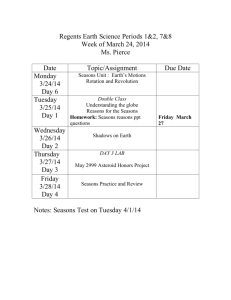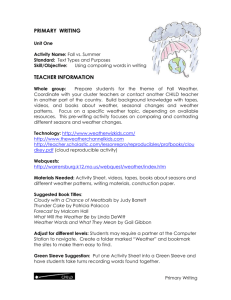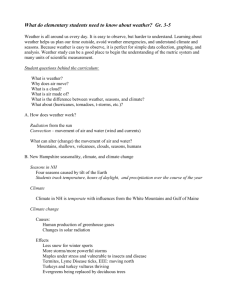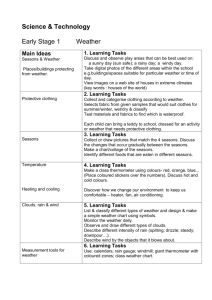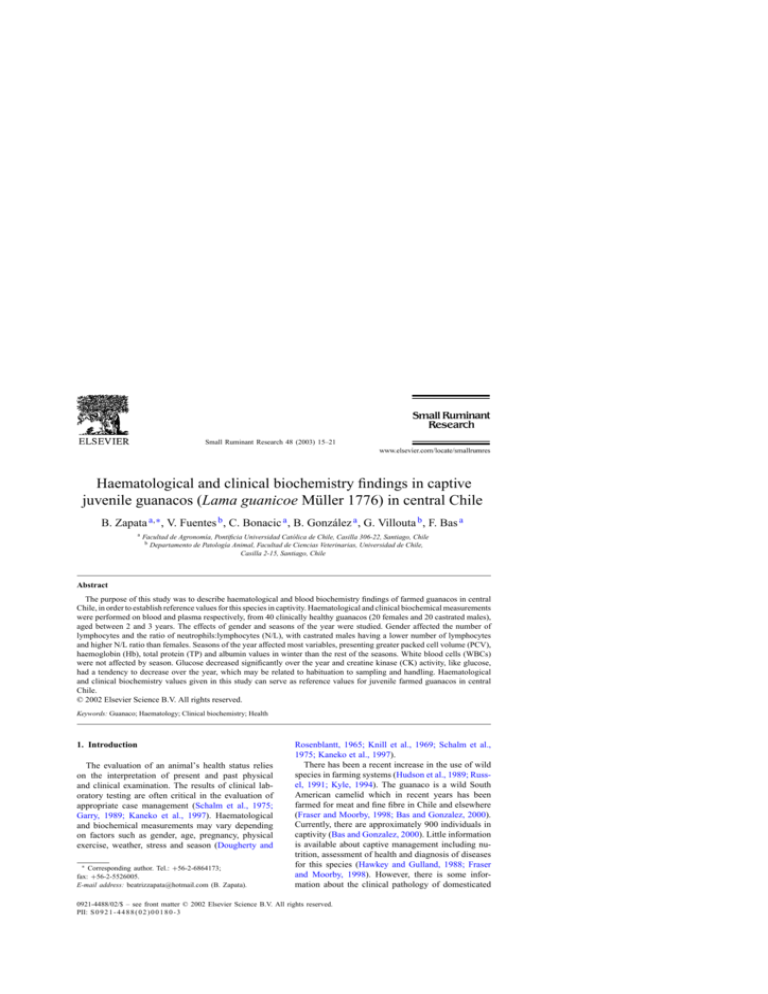
Small Ruminant Research 48 (2003) 15–21
Haematological and clinical biochemistry findings in captive
juvenile guanacos (Lama guanicoe Müller 1776) in central Chile
B. Zapata a,∗ , V. Fuentes b , C. Bonacic a , B. González a , G. Villouta b , F. Bas a
a
Facultad de Agronomı́a, Pontificia Universidad Católica de Chile, Casilla 306-22, Santiago, Chile
b Departamento de Patologı́a Animal, Facultad de Ciencias Veterinarias, Universidad de Chile,
Casilla 2-15, Santiago, Chile
Abstract
The purpose of this study was to describe haematological and blood biochemistry findings of farmed guanacos in central
Chile, in order to establish reference values for this species in captivity. Haematological and clinical biochemical measurements
were performed on blood and plasma respectively, from 40 clinically healthy guanacos (20 females and 20 castrated males),
aged between 2 and 3 years. The effects of gender and seasons of the year were studied. Gender affected the number of
lymphocytes and the ratio of neutrophils:lymphocytes (N/L), with castrated males having a lower number of lymphocytes
and higher N/L ratio than females. Seasons of the year affected most variables, presenting greater packed cell volume (PCV),
haemoglobin (Hb), total protein (TP) and albumin values in winter than the rest of the seasons. White blood cells (WBCs)
were not affected by season. Glucose decreased significantly over the year and creatine kinase (CK) activity, like glucose,
had a tendency to decrease over the year, which may be related to habituation to sampling and handling. Haematological
and clinical biochemistry values given in this study can serve as reference values for juvenile farmed guanacos in central
Chile.
© 2002 Elsevier Science B.V. All rights reserved.
Keywords: Guanaco; Haematology; Clinical biochemistry; Health
1. Introduction
The evaluation of an animal’s health status relies
on the interpretation of present and past physical
and clinical examination. The results of clinical laboratory testing are often critical in the evaluation of
appropriate case management (Schalm et al., 1975;
Garry, 1989; Kaneko et al., 1997). Haematological
and biochemical measurements may vary depending
on factors such as gender, age, pregnancy, physical
exercise, weather, stress and season (Dougherty and
∗ Corresponding author. Tel.: +56-2-6864173;
fax: +56-2-5526005.
E-mail address: beatrizzapata@hotmail.com (B. Zapata).
Rosenblantt, 1965; Knill et al., 1969; Schalm et al.,
1975; Kaneko et al., 1997).
There has been a recent increase in the use of wild
species in farming systems (Hudson et al., 1989; Russel, 1991; Kyle, 1994). The guanaco is a wild South
American camelid which in recent years has been
farmed for meat and fine fibre in Chile and elsewhere
(Fraser and Moorby, 1998; Bas and Gonzalez, 2000).
Currently, there are approximately 900 individuals in
captivity (Bas and Gonzalez, 2000). Little information
is available about captive management including nutrition, assessment of health and diagnosis of diseases
for this species (Hawkey and Gulland, 1988; Fraser
and Moorby, 1998). However, there is some information about the clinical pathology of domesticated
0921-4488/02/$ – see front matter © 2002 Elsevier Science B.V. All rights reserved.
PII: S 0 9 2 1 - 4 4 8 8 ( 0 2 ) 0 0 1 8 0 - 3
16
B. Zapata et al. / Small Ruminant Research 48 (2003) 15–21
species of camelids such as the alpaca (Lama pacos)
and the llama (Lama glama), which are currently used
as reference values for the guanaco (Lewis, 1976;
Montes et al., 1983; Lassen et al., 1986; Garry, 1989;
Fowler, 1989; Vallenas, 1991; Hajduk, 1992).
The guanaco, being a new farm species, joins some
other wild animals in captivity, for which little information is available about many of the haematological
and biochemical values commonly used to evaluate the health status of traditional livestock species
(Garry, 1989). Current available information on
haematology and clinical biochemistry is scarce and
comes from captured wild guanacos (Karesh et al.,
1998; Gustafson et al., 1998), where stress is likely to
have influenced measurements, or from small groups
(Lewis, 1976; Hawkey and Gulland, 1988; González
et al., 1998; Fraser and Moorby, 1998). In addition,
comparative studies of the haematological variables
and biochemical profiles of guanacos elsewhere, llamas and vicuñas have shown significant differences
between the species in some of the parameters measured (Hawkey and Gulland, 1988; González et al.,
1998). Although these species are very similar, it
has been recommended that specific reference values
should be obtained for each species (Fowler, 1989;
Zapata, 1999).
The purpose of this study was to describe haematological and biochemical values in a healthy guanaco
population under farming conditions. Differences due
to gender (females versus castrated males) and seasons
(summer, autumn, winter and spring) were studied in
order to obtain reference values for this species in captivity. No intact males were studied, because farming
conditions only allow a small number to be kept for
mating.
2. Materials and methods
2.1. Animals
Forty, clinically healthy, 2 and 3 years old guanacos (20 females and 20 castrated males), each weighing approximately 95 kg were randomly chosen from
71 guanacos reared in captivity. The guanacos graze
on 3 ha of naturalised pasture, and their diet is supplemented with alfalfa hay. This study was carried out
between May 1998 and March 1999.
The guanacos were weighed once a month and vaccinated in spring and autumn against clostridial diseases. A drop-floor restraint chute was used to restrain
guanacos for veterinary procedures and blood sampling before the study began. Animals were fed daily
by a stockperson. All these handling and training procedures were performed, not just to prevent and control diseases, but to familiarise the animals with people
and handling in order to minimise the stress response
to blood sampling.
2.2. Blood sampling
Blood samples were taken from the jugular vein
and collected into ethylene-diamine-tetraacetic-acid
(EDTA) and heparinized tubes (Vacutainer® , Becton
Dickson). These samples were used for haematology
and clinical biochemistry, respectively (Villouta et al.,
1997).
Heparinized tubes were centrifuged immediately.
The plasma obtained was subsequently separated into
1.5 ml microtubes and frozen at −70 ◦ C for further
analysis, which was carried out around 2 weeks later.
EDTA tubes were kept at room temperature for a maximum of 4 h before being analysed.
Blood samples were taken from each guanaco every morning on the following dates: autumn, between
28 May and 25 June; winter, between 12 and 21 August; spring, between 15 October and 5 November and
summer, between 4 and 26 March.
2.3. Measurements
Packed cell volume (PCV) and haemoglobin (Hb)
concentration were determined by the microhaematocrit and cyanmethaemoglobin method, respectively. Mean corpuscular haemoglobin concentration
(MCHC) was calculated using the standard formula
(Schalm et al., 1975). Total white blood cell (WBC)
counts were carried out in a Neubauer counting chamber using the haemacytometer technique. Blood films
on coverslips were fixed in absolute methanol and
stained with Giemsa and differential WBC counts
were performed according to Schalm et al. (1975).
In order to minimise the source of error, the total
white blood cell and differential cell counts were performed by the same experienced person (Dr. Gladys
Villouta, Professor of Clinical Pathology, in charge of
B. Zapata et al. / Small Ruminant Research 48 (2003) 15–21
the laboratory). Manual counts were used instead of
automated cell counts because in Chile few veterinary
clinical laboratories use this technique.
Total plasma protein (TP) and albumin were measured using the biuret and bromocresol green methods,
respectively, and globulin was estimated by difference. The activity of aspartate aminotransferase (AST,
EC 2.6.1.1, AST® ) and creatine kinase (CK, E.C.
2.7.3.2, CK Nac-activated® ) were measured at 30 ◦ C
by the UV test (Laboratory Boehringer Mannheim);
blood urea nitrogen (BUN) and glucose levels were
determined by Berthelot and glucose oxidase methods, respectively (Merckotest® ). Calcium (Ca) was
determined using o-cresolphthalein complexone and
inorganic phosphorous (P) was determined by a
colourimetric method, using the phosphomolybdate
technique (Merckotest® ).
2.4. Statistics
Descriptive statistics (mean, standard deviation and
range) were used to summarise the data for each season and gender, and a repeated measurement ANOVA
was conducted. Significant differences were considered at α = 0.05. Data normality was confirmed by
the Kolmogorov–Smirnov test. PCV (l/l) was arcsine
square root transformed and CK was log transformed
(Dytham, 1999). Repeated and simple contrasts were
used for analysing the effect of seasons on haematological and biochemical indicators.
17
3. Results
Red blood cell values and total and differential
white blood cell counts for guanacos are shown in
Tables 1 and 2. There was no significant difference
in the RBC values between the genders (P > 0.05),
however, there were some differences between seasons. The highest PCV and Hb values were observed
in winter (P < 0.05) and the lowest value of MCHC
was found in autumn (P < 0.05).
Effect of gender on white cells is shown in Table 3.
The number of lymphocytes (F (1, 35) = 25.44,
P < 0.05) and the ratio of neutrophils and lymphocytes (N/L) (F (1, 34) = 9.22, P < 0.05) were
affected by gender. Overall, males presented a lower
number of lymphocytes than females, and consequently had a higher N/L ratio. By season, males
had significantly lower number of lymphocytes than
females in all the seasons, except spring (P > 0.05),
and the N/L ratio was significantly higher in males
than females in all the seasons, except autumn (P >
0.05).
Table 4 shows the plasma biochemistry values
obtained from farmed guanacos. There was no significant effect of gender on plasma biochemistry
variables (P > 0.05). Nevertheless, most variables
showed significant differences between seasons (P <
0.05), except CK which presented a wide observed
range within each season. Except for the AST levels
between spring and summer (P > 0.05), AST and
Table 1
Red blood cell values in farmed guanacos (Lama guanicoe) in four seasons of the year
Variable
Autumn (N = 41)
Winter (N = 39)
0.34 ± 0.03 a
0.28–0.42
0.37 ± 0.02 b
0.29–0.42
Spring (N = 38)
Summer (N = 38)
PCVa
(l/l)
Mean ± S.D.
Range
0.36 ± 0.0 3 ac
0.30–0.43
0.33 ± 0.02 ad
0.28–0.37
Hbb (g/dl)
Mean ± S.D.
Range
15.5 ± 1.64 a
11.9–19
17.4 ± 1.23 b
13.8–19.5
16.7 ± 1.74 c
14–21.2
15.6 ± 1.22 d
13.1–17.9
MCHCc (g/dl)
Mean ± S.D.
Range
45.3 ± 3.64 a
36–54
47.0 ± 2.09 b
40.5–52
46.5 ± 1.98 b
42.3–53
47.0 ± 2.84 b
41.1–55.4
Letters a–d indicate significant differences among columns at 0.05 level.
a Packed cell volume.
b Haemoglobin.
c Mean corpuscular haemoglobin concentration.
18
B. Zapata et al. / Small Ruminant Research 48 (2003) 15–21
Table 2
White blood cell values in farmed guanacos (Lama guanicoe) in four seasons of the year
Autumn (N = 41)
Winter (N = 39)
Spring (N = 38)
Summer (N = 38)
Leukocytes
Mean ± S.D.
Range
9.5 ± 3.10
3.1–15.8
10.7 ± 2.90
5.1–20.2
10.2 ± 3.06
4.7–15.7
10.1 ± 2.66
5.1–20.0
Band cells (109 l−1 )
Mean ± S.D.
Range
0.22 ± 0.16
0.03–0.63
0.20 ± 0.08
0.08–0.39
0.25 ± 0.20
0.07–0.92
0.20 ± 0.10
0.08–0.40
Neutrophils (109 l−1 )
Mean ± S.D.
Range
6.3 ±2.61
0.90–12.10
6.94 ± 2.70
3.03–17.33
6.74 ± 2.42
3.35–12.25
6.56 ± 2.43
3.41–17.20
Lymphocytes (109 l−1 )
Mean ± S.D.
Range
2.83 ± 1.19
0.69–6.05
3.20 ± 1.19
1.42–6.04
2.83 ± 1.15
0.89–5.57
2.98 ± 1.28
0.57–6.57
Monocytes (109 l−1 )
Mean ± S.D.
Range
0.27 ± 0.13
0.06–0.53
0.35 ± 0.19
0.09–0.87
0.28 ± 0.17
0.05–0.89
0.28 ± 0.19
0.08–0.80
Eosinophils (109 l−1 )
Mean ± S.D.
Range
0.13 ± 0.08
0.06–0.31
0.23 ± 0.12
0.09–0.47
0.28 ± 0.18
0.08–0.62
0.17 ± 0.13
0.08–0.55
Basophils (109 l−1 )
Mean ± S.D.
Range
0.21 ± 0.22
0.06–0.76
0.12 ± 0.06
0.07–0.24
0.13 ± 0.04
0.08–0.21
0.32 ± 0.14
0.08–0.44
Variable
(109 l−1 )
Table 3
The effect of gender on lymphocytes and N/L ratio in farmed guanacos in central Chile during different seasons of the year
Season
Autumn
Winter
Spring
Summer
Lymphocytes (109 l−1 ) (mean ± S.D.)
N/L (mean ± S.D.)
Females
Females
3.4
3.7
3.2
3.7
±
±
±
±
1.17
1.16
1.20
1.30
Males
b (n = 20)
b (n = 19)
(n = 19)
b (n = 19)
2.3
2.7
2.5
2.2
±
±
±
±
0.92
1.01
1.00
0.77
aA (n = 21)
aB (n = 20)
AB (n = 19)
aAB (n = 19)
2.3
1.9
2.3
2.0
±
±
±
±
1.20
0.69
1.14
0.99
Males
(n = 20)
b (n = 19)
b (n = 19)
b (n = 19)
2.9
3.1
3.2
3.6
±
±
±
±
1.95
1.92
1.62
2.81
(n = 21)
a (n = 20)
a (n = 19)
a (n = 19)
Letters a, b indicate significant differences between genders at the 0.05 level and A, B indicate significant differences between seasons at
the 0.05 level.
glucose were always statistically different (P < 0.05).
Ca had the highest value in autumn, whereas P had
the lowest in this season (P < 0.05). TP and albumin
values peaked in winter (P < 0.05).
Glucose levels exhibited a significant decreasing
trend between consecutive seasons (P < 0.05). CK
activity also showed a possible tendency to decrease,
though it was not significant (P > 0.05).
4. Discussion
4.1. Red blood cells
PCV concentrations were similar to those reported
by other researchers. Karesh et al. (1998) reported values between 0.30 and 0.48 l/l in wild darted guanacos. In captive guanacos in zoos, PCV ranges between
B. Zapata et al. / Small Ruminant Research 48 (2003) 15–21
19
Table 4
Plasma biochemistry findings in farmed female and male guanacos (Lama guanicoe Müller) in central Chile in different seasons of the year
Autumn
Winter
Spring
Summer
BUNa
(mmol/l)
Mean ± S.D.
Range
4.6 ± 1.39 a
1.5–6.5
5.3 ± 1.27 b
3.3–7.6
5.6 ± 1.09 bc
3.6–7.8
5.8 ± 0.81 c
4.3–7.8
ASTb (U/L)
Mean ± S.D.
Range
127.7 ± 21.74 a
86–179
147.6 ± 35.20 b
99.0–227
135.7 ± 26.99 ac
80.0–196
104.9 ± 23.29 d
68–166
CKc (U/L)
Mean ± S.D.
Range
71.6 ± 93.53 a
24–540
79.8 ± 96.41 a
18.0–411
57.6 ± 56.81 a
12.0–310
43.3 ± 28.41 a
23–198
Ca (mmol/l)
Mean ± S.D.
Range
2.2 ± 0.33 a
1.4–2.9
2.0 ± 0.38 b
1.2–2.8
2.0 ± 0.31 b
1.5–2.9
1.8 ± 0.23 b
1.5–2.4
P (mmol/l)
Mean ± S.D.
Range
2.0 ± 0.31 a
1.3–2.6
2.4 ± 0.61 b
1.3–4.6
2.5 ± 0.45 bc
1.7–3.8
2.6 ± 0.36 c
1.8–3.3
Glucose (mmol/l)
Mean ± S.D.
Range
6.2 ± 1.44 a
4.3–10.6
6.2 ± 1.06 a
4.4–9.3
4.2 ± 0.69 b
2.7–5.5
5.0 ± 0.68 c
3.5–6.6
TPd (g/l)
Mean ± S.D.
Range
54.0 ± 5.10 a
46.0–65.0 a
63.0 ± 4.0 b
54.0–71.0
57.0 ± 7.0 c
44.0–69.0
51.0 ± 4.0 d
45.0–61.0
Albumin (g/l)
Mean ± S.D.
Range
35.0 ± 5.0 a
26.0–46.0
41.0 ± 4.0 b
30.0–50.0
38.0 ± 4.0 c
30.0–45.0
38.0 ± 4.0 c
30.0–44.0
Globulin (g/l)
Mean ± S.D.
Range
19.0 ± 6.0 a
7.0–32.0
22.0 ± 6.0 a
10.0–39.0
20.0 ± 6.0 a
10.0–35.0
14.0 ± 6.0 b
5.0–28.0
Letters a–d indicate statistical difference among seasons at the 0.05 level.
a Blood urea nitrogen.
b Aspartate aminotransferase.
c Creatine kinase.
d Total protein.
0.36 and 0.42 l/l (González et al., 1998; Hawkey and
Gulland, 1988). These values are similar to alpacas
(Hajduk, 1992). In the majority of previous reports of
domesticated camelids, PCV level differed between
sexes (Montes et al., 1983; Garry, 1989). In this study,
PCV values were not significantly different between
genders.
PCV, Hb, TP and albumin concentrations were
significantly higher in winter than the other seasons.
This increase may be interpreted as haemoconcentration probably due to slight dehydration (Meyer et al.,
1992), caused probably by decreased access to water,
which was temporarily frozen in the morning during
winter.
4.2. White blood cells
The number of leukocytes were within the
range that has been reported for captive zoo guanacos by González et al. (1998) ((8.6–11.2) ×
109 l−1 ) and by Hawkey and Gulland (1988)
((2.7–14.7) × 109 l−1 ), but lower than values reported from wild caught guanacos by Karesh
et al. (1998) ((14.2–30.3) × 109 l−1 ). This increased
20
B. Zapata et al. / Small Ruminant Research 48 (2003) 15–21
value of leukocytes was speculated to be a trapping
and handling stress response (Karesh et al., 1998).
In general, WBC differential counts were similar to
values reported by González et al. (1998) and Hawkey
and Gulland (1988), but lymphocyte and eosinophil
numbers were slightly lower in this study than was
reported by Hawkey and Gulland (1988).
Except for the number of lymphocytes and N/L ratio, WBC were not affected by gender, as was reported
for alpacas (Montes et al., 1983). Males presented
overall a lower number of lymphocytes and higher N/L
ratio than females.
It is well known that physiological stress response,
induced by an increase of endogenous corticosteroids
in the bloodstream, is accompanied by neutrophilia,
lymphopenia, monocytosis and eosinopenia and an increased N/L, however there are variations between
species, e.g. horses usually show no monocyte change
(Meyer et al., 1992). The mechanism of lymphopenia
is associated with lympholysis in blood and lymphoid
tissues and/or altered distribution of lymphocytes out
of the vascular pool into other body compartments,
such as the marrow (Jain, 1986). In South American
camelids, leukocyte kinetics seem to be different from
those of other ungulate species. Although no studies
have documented the degree of change expected in
the WBC count in response to stress, clinical research
in llamas suggests that in adult llamas, a lymphocyte
count less than 1 × 109 l−1 has been described as indicative of stress (Garry, 1989). In the current study,
the lower limit of the observed range for the number
of lymphocytes was similar to the figure described as
indicating a stress response. Thus, a stress response
may be masking the real values in juvenile guanaco
males.
In this study, the finding of reduced lymphocyte
count observed in castrated males, compared with
females, and the interpretation of this as a sign of
stress response is consistent with the social behaviour
of the males in the wild, which consists of permanent
hierarchical fights most common among guanacos
aged 3–4 years old (Wilson and Franklin, 1985). Despite the fact that the studied males were castrated
and their hierarchical fights are less frequent than
intact males, they do, in practice, fight in captivity.
Thus, their social behaviour may contribute to elevated stress, which the male guanacos have to cope
with.
4.3. Clinical biochemistry
In this study, most biochemical variables were similar to values reported for llamas (Fowler and Zinkl,
1989; Lassen et al., 1986) and for wild guanacos
(Fraser and Moorby, 1998; González et al., 1998;
Karesh et al., 1998). However, this study reports
lower concentrations of blood glucose than these earlier studies. This might be because the guanacos were
familiarised to handling, presence of people and the
blood sampling procedure, and therefore less stressed
than animals in the other studies.
There were no differences in clinical biochemistry
between genders, but there were significant differences between seasons. The BUN levels showed
changes over seasons; the lowest values were observed in autumn and then increased over seasons
until spring and summer. These findings might be
explained by the quality of ingested diet, particularly
the protein intake. Alfalfa hay supplementation was
higher in winter, because of diminished availability of
pasture during winter. Pasture starts to grow slowly
from August up to November when there is both best
quality and quantity of grasses (Avendaño, 1988).
CK activity and glucose level had a tendency to decrease over seasons. Both are related to the response
of the animals to blood sampling. Glucose increases
as part of the stress response and CK activity also increases with muscular exertion produced by attempts
to escape during sampling (Meyer et al., 1992). The
CK activity showed a wide range of values, indicating
that CK varied considerably between animals, probably due to individual temperament. Nevertheless, the
CK activity had a tendency to decrease over time, with
a wide range of variation. The fall in the level of both
glucose and CK may indicate a gradual habituation to
handling over time.
5. Conclusions
In farmed guanacos living in central Chile, gender
affected only the number of lymphocytes and the ratio of neutrophils: lymphocytes; castrated males had
a lower number of lymphocytes and a higher N/L
ratio. Most variables were affected by season. PCV,
Hb, TP and albumin were increased in winter, indicating haemoconcentration, probably due to dehydration.
B. Zapata et al. / Small Ruminant Research 48 (2003) 15–21
Except for the number of lymphocytes in males, WBC
did not change with season. Plasma biochemistry was
not affected by gender, but was influenced by season.
Most differences between seasons may be explained
by differences in availability of forage and the stress
response to handling.
Differences found between genders and seasons did
not have clinical relevance because animals were clinically healthy, therefore the values presented in this
study can serve as reference values for juvenile farmed
guanacos in central Chile.
Acknowledgements
We are very grateful to Dr. David Anderson, Ruth
Cox and Simon Milward for their help and suggestions
during the writing of this paper. Funding for this study
was provided by the Chilean Ministry of Agriculture
(FIA, Project No. A94-0-056) and the Wellcome Trust
057689/Z/99/Z.
References
Avendaño, J., 1988. Praderas sembradas en zonas mediterraneas.
In: Ruiz, I. (Ed.), Praderas Para Chile INIA, p. 723.
Bas, F., Gonzalez, B., 2000. Current advances in research and
management of the guanaco (Lama guanicoe) in Chile. Ciencia
e Investigación Agraria 27 (1), 51–65.
Dougherty, J.H., Rosenblantt, L.S., 1965. Changes in hemogram
of the beagle with age. J. Gerontol. 20, 131.
Dytham, C., 1999. Choosing and Using Statistics: A Biologists
Guide. Blackwell Scientific Publications, Oxford, p. 200.
Fowler, M.E., 1989. Hemic and lymphatic systems. In: Medicine
and Surgery of South American Camelids, 5th ed. Iowa State
University Press, Ames, pp. 263–269.
Fowler, M.E., Zinkl, J.G., 1989. Reference values for hematologic
and serum biochemical values in Ilamas (Lama glama). Am.
J. Vet. Res. 50 (12), 2.049–2.053.
Fraser, M.D., Moorby, J.M., 1998. Plasma biochemical values in
the guanaco (Lama guanicoe) and a comparison with the sheep.
Anim. Sci. 66, 209–216.
Garry, F., 1989. Clinical pathology of llamas. Vet. Clin. North
Am. Food Anim. Pract. 5 (1), 55–65.
González, M.J., Lombardo, D.M., Delhon, G.A., Lawzewitsch,
I., 1998. Determinación de parámetros hematológicos de tres
especies de camélidos sudamericanos en cautiverio. Veterinaria
Argentina XV, 102–108.
Gustafson, L., Franklin, W., Sarno, R., Hunter, R., Young,
K., Johnson, W., Behl, M., 1998. Predicting early mortality
21
of newborn guanacos by birth mass and hematological
parameters: a provisional model. J. Wildlife Manage. 62 (1),
24–35.
Hajduk, P., 1992. Haematological references values for alpacas.
Aus. Vet. J. 69 (4), 89–90.
Hawkey, C.M., Gulland, F.M.D., 1988. Haematology of clinically
normal and abnormal captive llamas and guanacoes. Vet. Rec.
122, 232–234.
Hudson, R.J., Dreww, K.R., Baskin, L.M., 1989. Wildlife
production systems. In: Economic Utilisation of Wild
Ungulates. Cambridge University Press, Cambridge.
Jain, N.C., 1986. Schalm’s Veterinary Hematology. Lea and
Febiger, Philadelphia, p. 1221.
Kaneko, J., Harvey, J., Bruss, M., 1997. Clinical Biochemistry of
Domestic Animals, 5th ed. Academic Press, New York, p. 932.
Karesh, W., Uhart, M., Dierenfeld, E., Braselton, E., Torres, A.,
House, C., Puche, H., Cook, R.A., 1998. Health evaluation of
free-ranging guanaco (Lama guanicoe). J. Zoo Wildlife Med.
29 (2), 134–141.
Knill, L.M., McConaughy, C., Camarena, J., Day, M., 1969.
Hemogram of arabian horse. Am. J. Vet. Res. 30, 295–298.
Kyle, R., 1994. New species for meat production. J. Agric. Sci.
123, 1–8.
Lassen, E.D., Pearson, E., Long, P., Schmotzer, W., Kaneps, A.J.,
Riebold, T.W., 1986. Clinical biochemical values of llamas:
reference values. Am. J. Vet. Res. 47 (10), 2278–2280.
Lewis, H.J., 1976. Comparative hematology-studies on camelidae.
Comp. Biochem. Physiol. 55A, 367–371.
Meyer, D.J., Coles, E., Rich, L.J., 1992. Veterinary Laboratory
Medicine: Interpretation and Diagnosis. Saunders, Philadelphia.
Montes, G., Stutzin, M., Correa, J., Glade, A., 1983. Estudio
hematológico de proteı́nas totales y fibrinógeno en alpacas
(Lama pacos) de la Provincia de Parinacota, Chile. Archivos
de Medicina Veterinaria 15 (1), 37–41.
Russel, A., 1991. Alternative animals for fibre production. In:
Proceedings of the Seminar of the Community Programme for
the Coordination of Agricultural Research, Peebles, UK, 24–25
October.
Schalm, O.W., Jain, N.C., Carrol, E.J., 1975. Veterinary Hematology, 3rd ed. Lea and Febiger, Philadelphia, 807 p.
Vallenas, A., 1991. Caracterı́sticas Anatomofisiológicas. In:
Fernández-Baca, S. (Ed.), Avances y Perspectivas del
Conocimiento de los Camélidos Sudamericanos. FAO, Oficina
Regional para América Latina y el Caribe, Santiago, Chile,
pp. 12–62.
Villouta, G., Hargreaves, R., Riveros, V., 1997. Haematological and
clinical biochemistry findings in captive Humboldt penguins
(Sphenicus humboldti). Avian Pathol. 26, 851–858.
Wilson, P., Franklin, W.L., 1985. Male group dynamics and intermale aggression of guanacos in southern Chile. Z. Tierpsychol.
69, 305–328.
Zapata, B., 1999. Diferenciación de camélidos sudamericanos
mediante el análisis de cariotipo. Tesis para optar al grado de
Magister en Producción Animal. Pontificia Universidad Catolica
de Chile, Santiago, Chile, p. 140.


